Perfect Kaju Katli or Kaju Barfi is a traditional Indian cashew fudge candy that’s terrifically smooth, thin, and melts in your mouth. This lovely treat includes a hint of rose but is completely customizable with your favorite flavors. And while it’s not the easiest recipe to make from scratch, I promise it’s worth every bit of effort! My step-by-step photos, video and instructions will help you make this foolproof kaju katli recipe as a dessert for yourself or a sweet gift for family and friends.
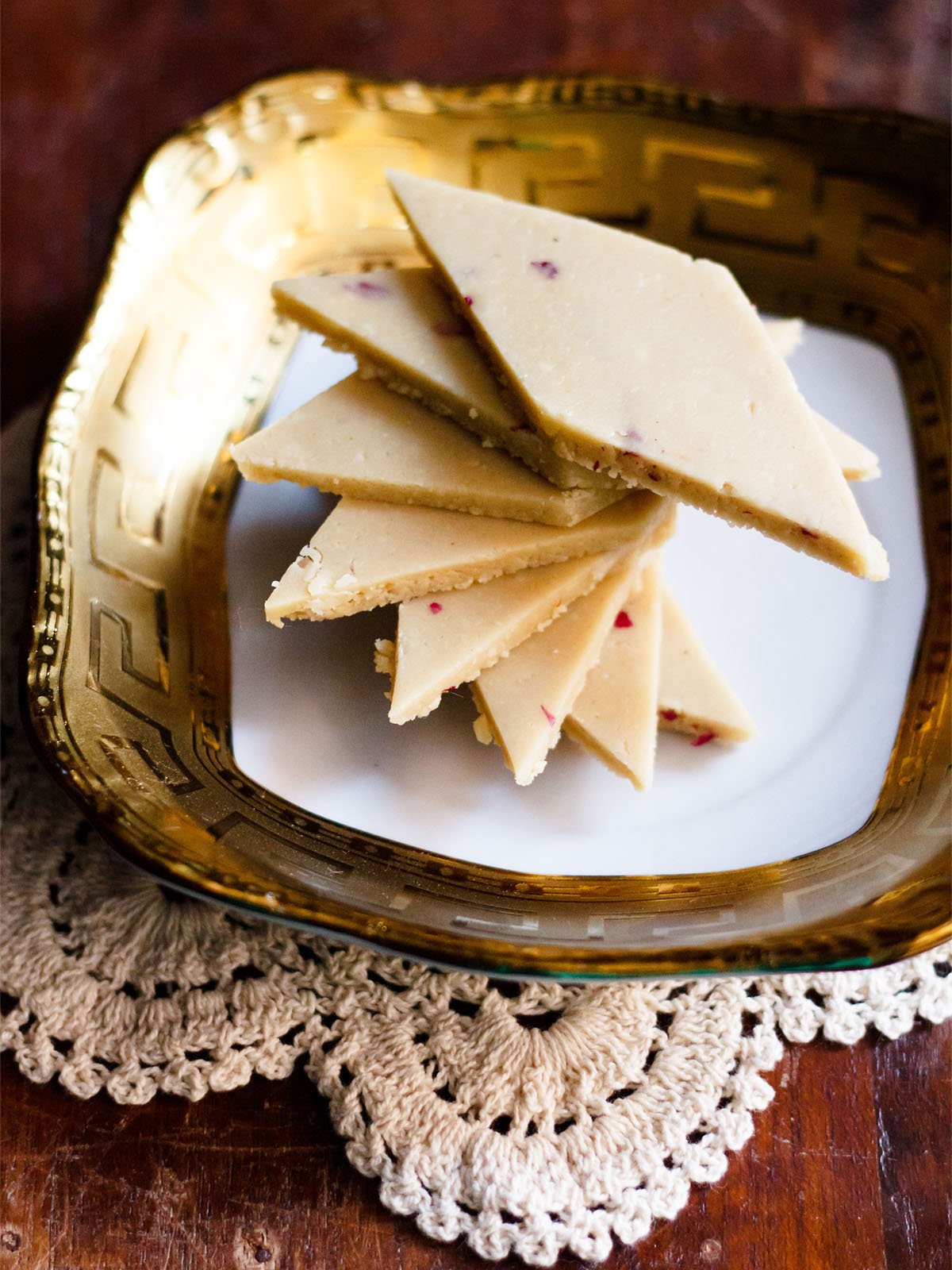
About This Kaju Katli Recipe
Kaju Katli is a traditional cashew fudge, and is one of the most sought after and loved Indian sweets. Whenever we get a big box at home they disappear in a matter of days.
If you stay in North India during Diwali festival you might receive a box of kaju katli or dry fruits as a gift. Kaju Katli is one of the most popular sweets which is gifted to relatives and friends during the diwali festival.
Kaju Katli is also called as Kaju Burfi. But, unlike thick burfi, kaju katli should be thin. In fact the word ‘katli’ means ‘thin slices.’
Now, I will not say making kaju katli at home is easy. Honestly speaking it is not. If you are making for the first time, then just forgive yourself if the kaju katli does not turn out perfectly. It will get easier as you practice, I promise!
When I started making this recipe, I tried different methods and all of them were not that good. Learning from my trials, I was able to develop this foolproof recipe of kaju katli where you do not need to check the consistency of sugar syrup.
My step-by-step guide below is a sincere attempt to share the method to get the perfect kaju katli at home every time!
Ingredients You Need
What is simple about this kaju barfi recipe is the ingredients list. You only need cashews, sugar, water, and butter, ghee or coconut oil – if you like. I find the added fat from the ghee or coconut oil makes a softer, smoother katli dough.
I have also added fresh organic rose from my balcony garden in the kaju katli recipe. This is totally optional and you can just skip it.
If you prefer you can even add rose water or saffron. Otherwise there are no flavorings added in this kaju katli recipe. The slightly sweet, deliciously nutty flavor of the cashews really shines in this dessert.
Speaking of shine, edible silver foil (varak) is also traditionally placed on kaju burfi when served for special occasions or given as gifts. Since I don’t use varak, I have skipped it completely.
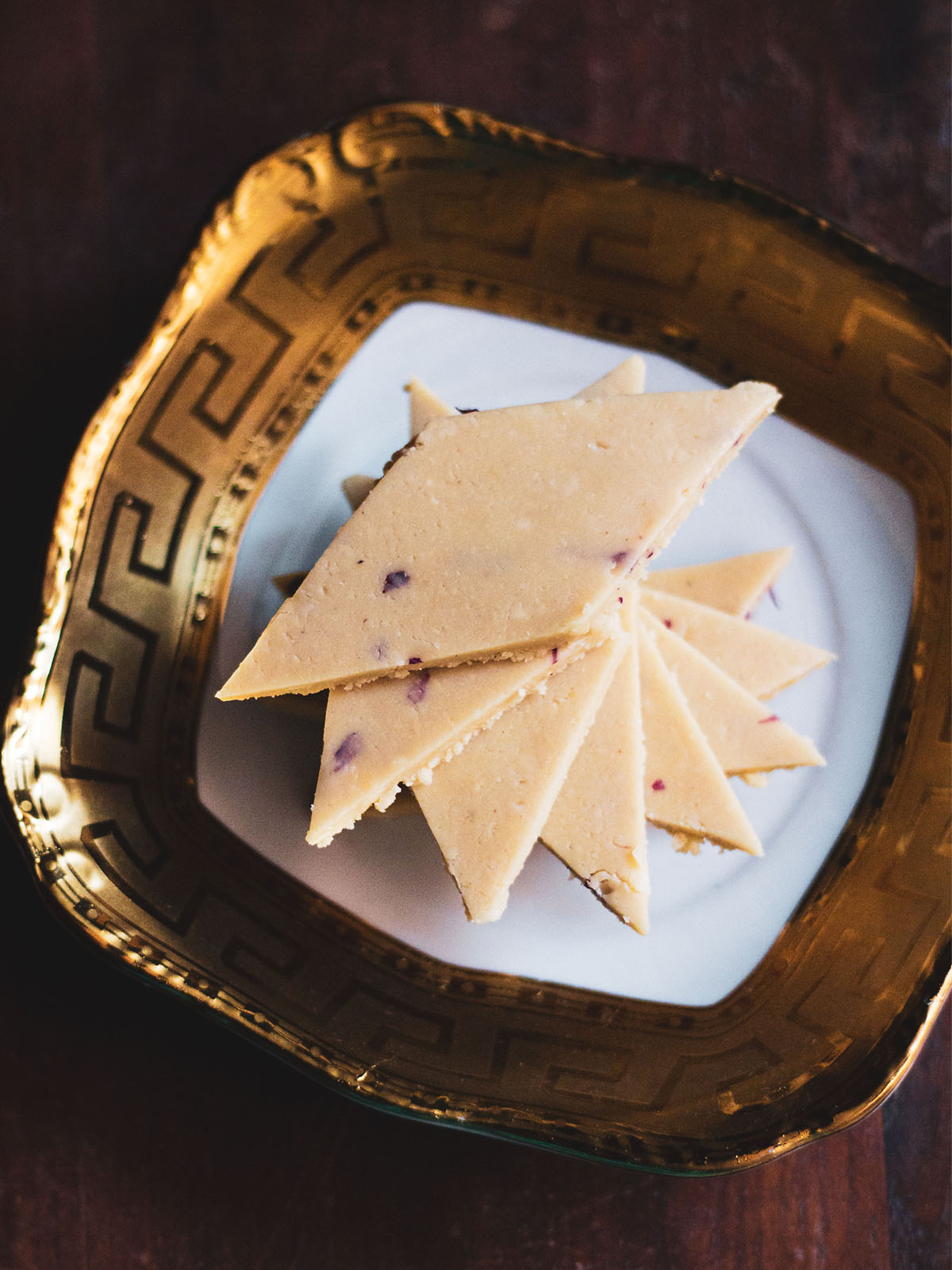
How to Make Kaju Katli
Here are my step-by-step photos and instructions for making perfectly sweet, melt-in-your-mouth Indian cashew fudge.
Powder Cashews
1. Place 1 cup cashews (kaju) in a dry grinder or coffee grinder or blender. I usually keep cashews at room temperature. Hence the cashews are dry.
Avoid using refrigerated or frozen cashews as they will release moisture once ground and turn more into a cashew paste.

2. Grind the kaju to a smooth powder, making sure you don’t over do the grinding process as fat should not release from the cashews.
I ran the mixer at a stretch first and then scraped the sides and ran again at intervals for a couple of times.
The cashews should be in powder form and not become pasty or buttery like cashew butter.
If there are tiny pieces in the cashew powder, then just let it be – or you can also sieve the cashew powder and set aside. Use a medium fine sieve and not a fine one to sift the powdered cashews.
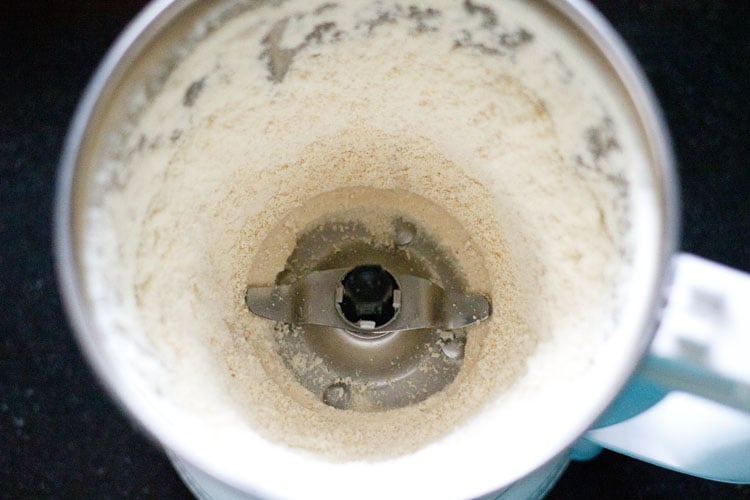
Make Cashew Dough
3. Combine ½ cup sugar and 5 tablespoons water in a thick bottomed pan (or kadai or a non-stick pan).

4. Keep on low flame and let the sugar dissolve in the water. There is no consistency in the sugar syrup like one string or two string. Simply let the sugar dissolve in the water and then proceed with the next step.
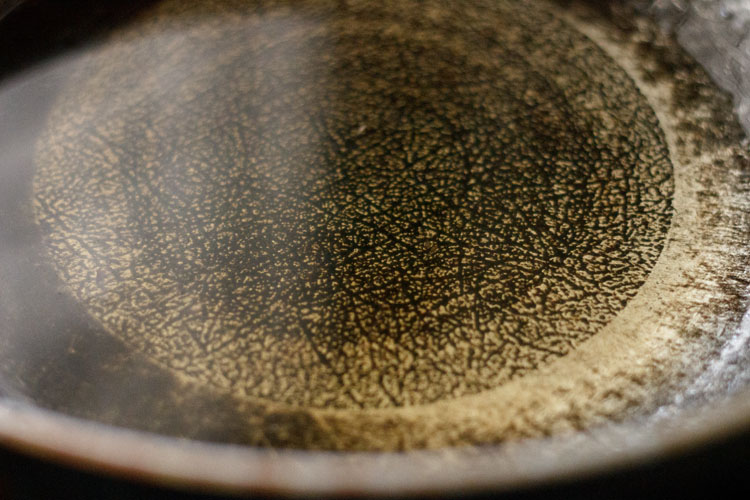
5. When the sugar completely dissolves in the water, add the cashew powder.
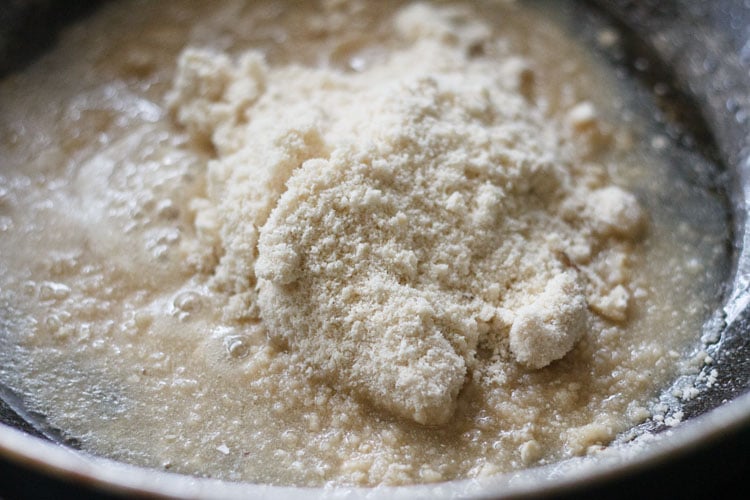
6. Stir and keep on stirring non-stop on a low flame. If there are lumps then break the lumps as you stir and continue to stir. This consistent stirring is the key for a smooth and even kaju katli dough.
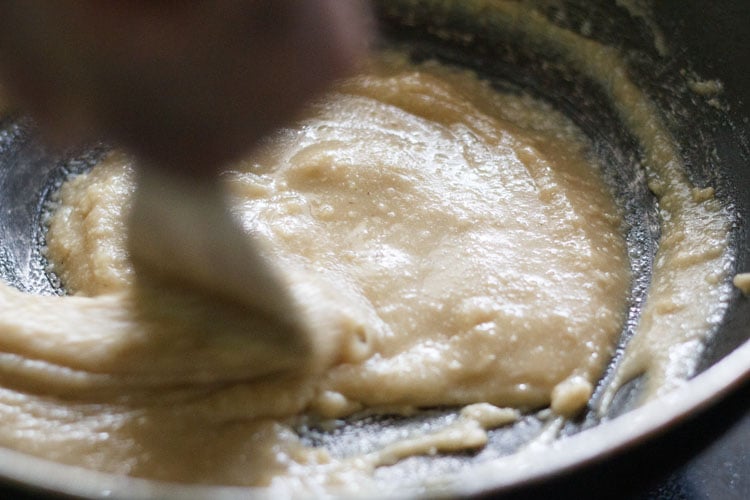
7. The mixture will thicken and start coming together to form a very soft dough. Then it is time to remove the whole lump of the mixture from the pan and place it on a work surface. This process of making the kaju katli dough took me exactly 8 minutes on a low flame.
Depending on your temperature, pan etc you can use a time span of 7 to 9 minutes after adding the cashew powder.
Another way of checking is taking a small piece of the dough and form into a ball. The ball should not stick to your fingers and be smooth. Do not scrape the edges as they are sticky and chewy.

Knead The Dough
8. Put the entire cashew dough on a work surface. Add 1 teaspoon rose petals (or 1 teaspoon rose water or 8 to 9 strands of saffron) and 1 tablespoon ghee or coconut oil. The addition of rose petals and coconut oil or ghee are optional.
The dough will be very hot, so let it rest for a minute or two until just hot enough to touch. When the heat is enough to handle begin to knead the dough.

9. Knead the dough lightly, flatten it and place it on a greased plate or tray. Don’t overdo kneading as this will release fat from the cashews. The grainy texture in the dough goes away as you knead it. Remember the dough should be hot while kneading.
You can also apply some oil or ghee on your palms instead of adding ghee/oil separately. If the dough looks too soft, add a teaspoon of some dried milk powder. If the dough looks dry or dense add a teaspoon of milk to soften it.

10. You can also place it on a large piece of parchment or butter paper. The cashew dough should still be quite warm when you start rolling it. As it cools it will harden more and then becomes difficult to roll, so work quickly!
Gently roll the kaju barfi dough with a rolling pin to make it even. There will be fine cracks in the dough.
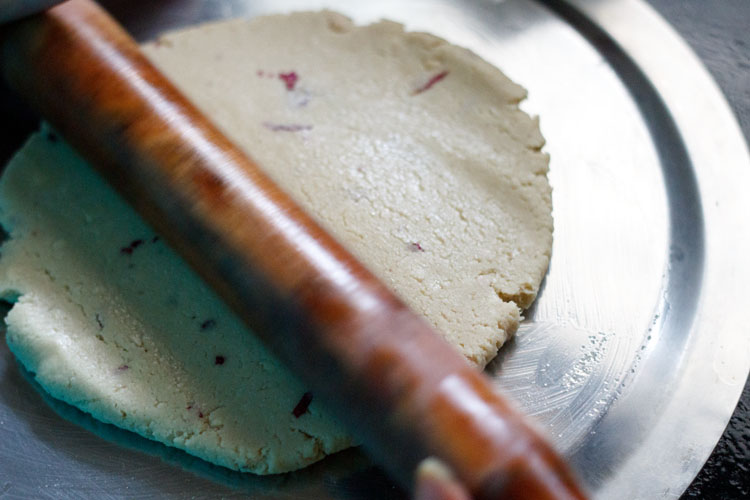
11. To smoothen the cracks, place parchment paper on top and roll more. This will fill in the cracks and the kaju barfi will have a smooth finish.
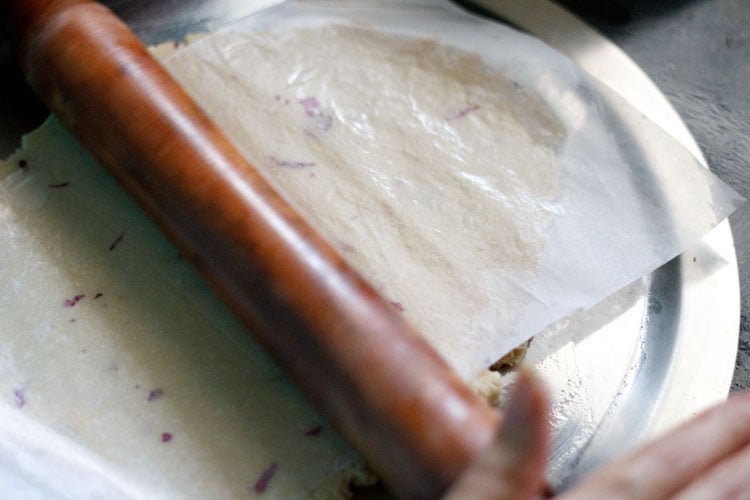
12. Roll to get a thickness of about 3 to 5 mm (about ⅛ inch). Then let the rolled cashew dough cool.
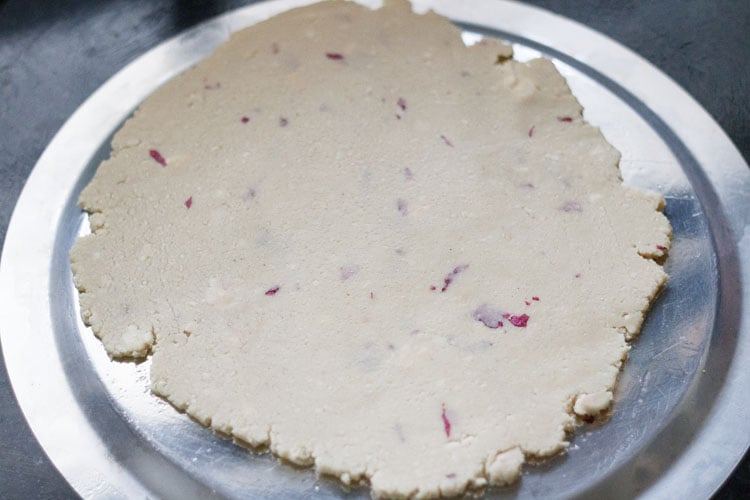
Make Kaju Katli
13. Once cooled completely, cut the cashew dough into squares or diamond shapes. Scrape off the uneven edges and enjoy as a little snack as you work.
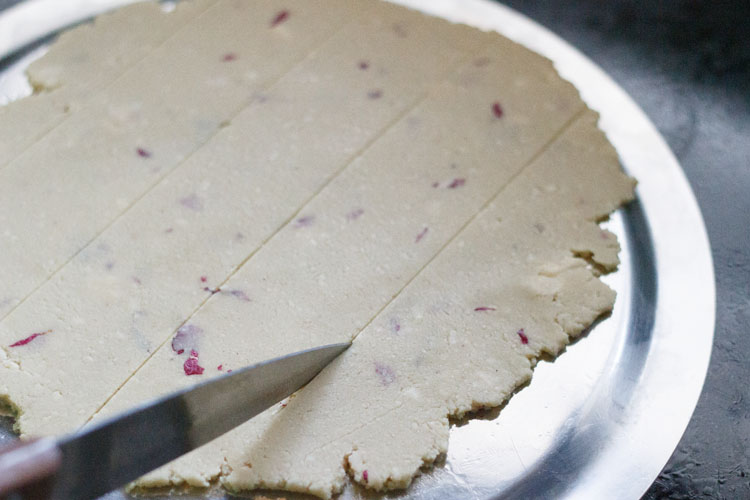
14. I recommend that you use a butter knife to gently remove the kaju barfi pieces from the bottom of the tray or paper, taking care that they do not break.

15. Arrange them on a plate one at a time as you go. Serve kaju katli or kaju barfi right away, or store them in an airtight container.
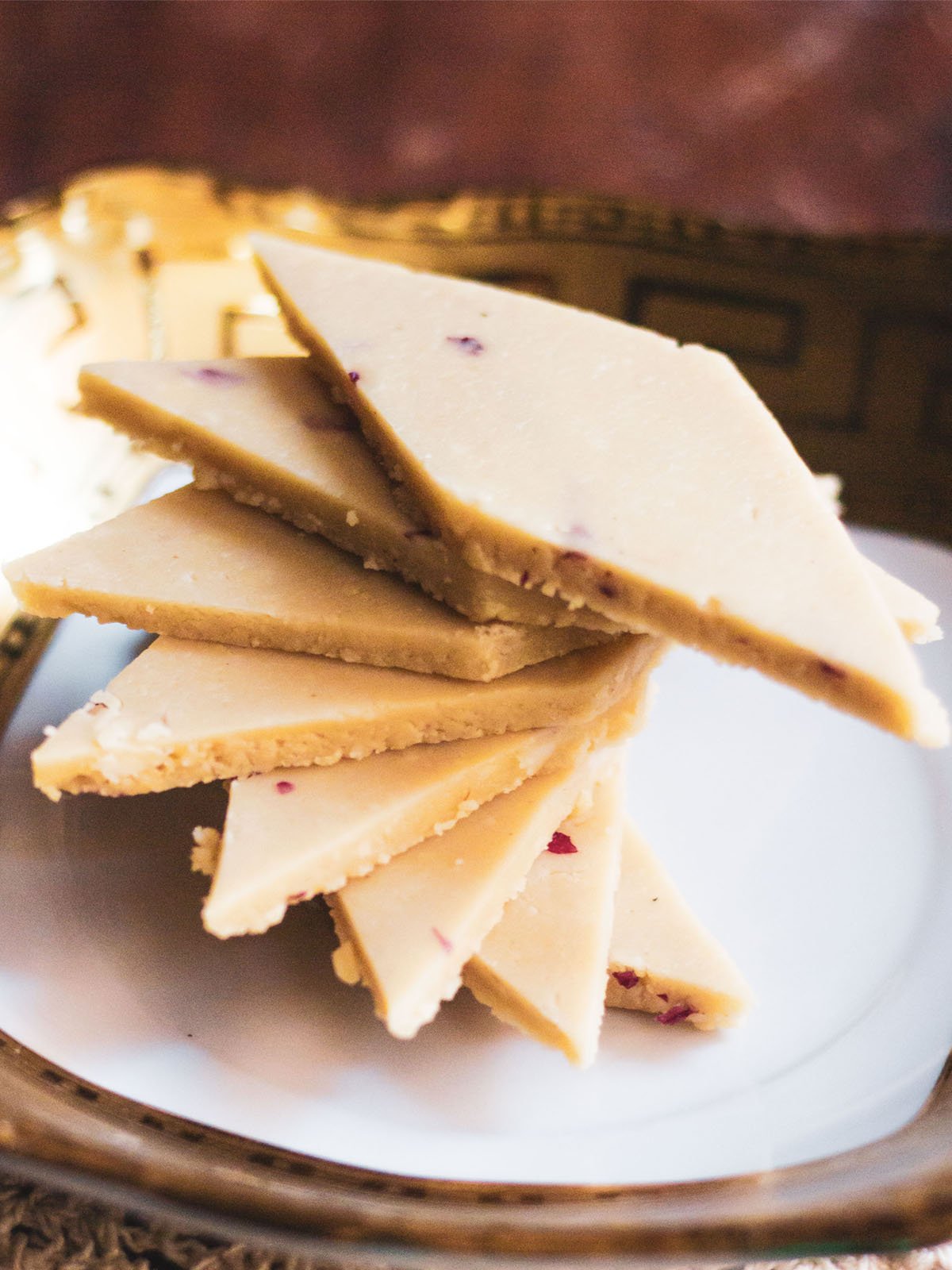
Let me tell you, kaju katli will be your new favorite treat. Make a batch for any festive occasion or just as a fun and delicious project!
For more delicious sweets recipes you can check this collection of 121 Diwali sweets.
Expert Tips
I share below some essential tips for making the best kaju katli recipe.
- Powdered cashew texture: You have to powder cashews finely. When powdering them, use the pulse option in your blender or blend in intervals of some seconds. Do not blend at a long stretch as we just want powdered cashews. The fat should not release from the cashews while blending and you definitely do not want cashew butter.
- Consistency of the sugar syrup: In this recipe, you just need to melt the sugar in the water first and then add the cashew powder. Mix and continue to cook till the cashew dough begins to leave the sides of the pan and comes together.
- Cashew dough texture: The cashew dough should be soft but not sticky. If you roll a tiny ball from the dough it should not stick to your fingers but be smooth.
- Kneading cashew dough: Kneading helps in binding the dough making it even and smooth. If you roll the dough directly, the kaju barfi won’t be even, smooth and will have a grainy texture.
Knead the dough lightly. The fat should not release when kneading the dough. The grainy texture of the dough goes away if you knead it well.
If the the dough looks more softer, then add a teaspoon of some milk powder to it and mix. If the dough looks dry or dense, add a teaspoon of milk to soften it.
FAQs
Use cashews that are neither salted nor toasted – just plain cashews.
If you used coconut oil or a neutral oil or ghee, they can be kept at room temperature for at least two weeks or in the fridge for up to a month.
Cashew fudge made with butter should be eaten in a day or two, or can be kept in the fridge for up to two weeks.
In this recipe I used fresh chopped rose petals. You can also add a splash of rose water for a light floral taste that goes well with the nutty cashew flavor.
For a slightly more fragrant kaju barfi, add a few threads of saffron while forming the dough. Try cardamom cashew fudge by adding a dash of ground cardamom seeds to the dough. Or use a bit of vanilla extract for an even more indulgent dessert.
If you fudge turns out shiny, you likely overworked the cashews and released the natural fats. Next time make sure your cashews are room temperature (not cold), that you don’t grind them too much, and you are careful to not overwork the dough.
For kaju barfi that seems sticky, it is possible that the sugar did not cook to the right consistency when cooking the dough. You will need to cook for a few more minutes.
You also might want to add a bit of evaporated milk powder as you form the dough if it is still too soft. Sprinkle in little by little until the dough reaches the perfect consistency, making sure again to not handle it so much that fats are released.
You can use parchment paper or aluminium foil.
Yes, you can definitely make a small or large batch. Making a large batch would require plenty of stirrings.
You can add some milk and grind to a smooth paste and follow the recipe. Alternatively, when cooking cashew paste, you could also add some milk powder or khoya (mawa).
You can place the dough back in the pan, add a few splashes of water and continue to cook for a some more minutes.
You can try and it should work.
More Burfi Recipes
Sweets Recipes
Sweets Recipes
Sweets Recipes
Sweets Recipes
If you’ve tried this recipe, please rate it in the recipe card or leave a comment below – I’d love to hear your feedback. For more vegetarian inspiration, sign up for my email updates or follow me on Instagram, Youtube, Facebook, Pinterest or X.

Kaju Katli Recipe | How to make Kaju Barfi
Ingredients
- 1 cup/160 grams cashews (whole), at room temperature
- ½ cup/100 grams sugar
- 5 tablespoons water
- 1 tablespoon Ghee or coconut oil or any neutral tasting oil, optional
- 1 teaspoon chopped rose petals or 1 teaspoon rose water or 8 to 9 strands of saffron, optional
Instructions
Powdering Cashews
- Add the cashews to a spice grinder, blender or a mixer-grinder. Use cashews that are at room temperature and not refrigerated ones.
- Grind the kaju to a smooth and fine powder, but make sure you don't over do the grinding process as fat should not release from the cashews.
- Remember to grind in short intervals. The cashews should be in powder form and not become pasty or buttery like cashew butter.
- If there are tiny pieces in the cashew powder, then just let them be. Or opt to sieve the cashew powder and set aside. Use a medium fine sieve and not a fine one to sift the powdered cashews.
Making Cashew Dough
- On a low flame heat sugar and water in a thick bottomed or non stick pan or kadai.
- Meanwhile grease a plate or a tray and keep aside or keep butter papers ready.
- When all the sugar has dissolved in the water, add the cashew powder. There is no consistency in the sugar syrup required like one string or two string. Simply let the sugar dissolve in the water and then proceed with the next step.
- Mix and keep on stirring the cashew mixture non-stop on a low flame.
- The cashew mixture would start thickening.
- Cook the kaju mixture for approx 7 to 9 minutes until the whole dough starts to come together.
How to make Kaju Katli
- Remove the whole lump of the kaju dough from the pan and place it on your work surface or in a bowl or plate.
- Add the rose petals and ghee or oil to the cashew mixture.
- When the heat in the dough is hot enough to handle, then knead the cashew mixture lightly.
- Flatten the dough and place it on a butter paper or on a greased plate or tray.
- Place a butter paper on top and then using a rolling pin, roll gently the dough from all sides till you reach a thickness of 3 to 5 mm in the dough.
- Remove the butter paper and let the rolled dough cool.
- When completely cooled, using a sharp knife cut the cashew dough giving square or diamond shapes.
- Gently remove the kaju barfi with a butter knife.
- Serve the kaju katli straight away or keep in an airtight container.
Video
Notes
Helpful Tips:
- Powdered cashews: The cashews need to be powdered finely. When powdering them, use the pulse option in your blender or blend at intervals of some seconds. Do not blend at a long stretch. The fat should not release from the cashews while blending and you definitely do not want cashew butter.
- Consistency of the sugar syrup: In this recipe, you just need to melt the sugar in the water first and then add the cashew powder. Mix and continue to cook till the cashew dough begins to leave the sides of the pan.
- Cashew dough texture: The cashew dough should be soft but not sticky. If you roll a tiny ball from the dough it should not be sticky but smooth.
- Kneading cashew dough: Kneading helps in binding the dough making it even and smooth. If you roll the dough directly, the kaju barfi won’t be even, smooth and with a grainy texture.
- Make ahead and storage: You can make a large batch and store to munch upon kaju katli any time! If using coconut oil or a neutral oil or ghee, kaju katli can be kept at room temperature for at least two weeks or in the fridge for up to a month. Cashew fudge made with butter should be eaten in a day or two, or can be kept in the fridge for up to two weeks.
Ingredient Notes
- If using saffron, then roast them first in a dry pan and then coarsely powder them in a mortar-pestle. Add the powdered saffron to the cashew dough.
- If using rose water, then add it to the sugar and water solution.
- For cardamom powder, add ½ teaspoon of it.
- Use plain cashews which are not salted, toasted or fried.
Nutrition Info (Approximate Values)
This Kaju Katli recipe from the archives was first published on October 2013. It has been updated and republished on October 2022.


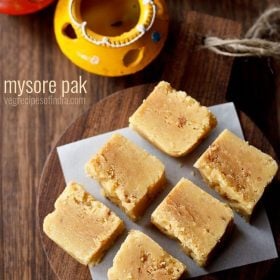

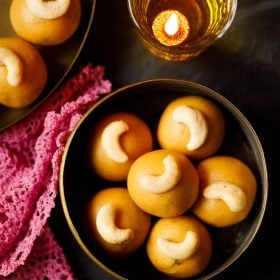
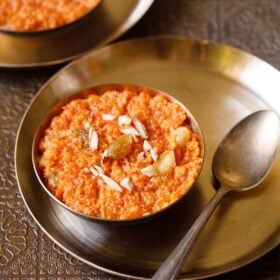
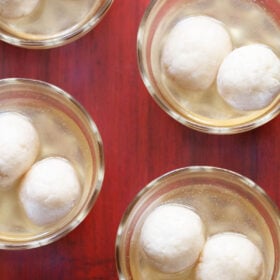
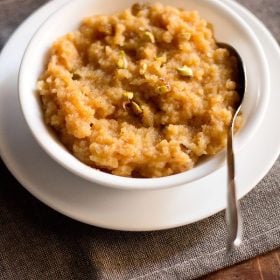








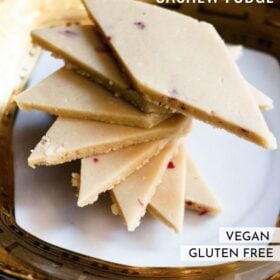
Hi, first time I tried it was really good but don’t know what is going wrong every time i am trying after this. It’s becoming very hard. Can you please help.
Looks like the cashew mixture is getting overcooked. The sugar in the mixture will thicken more and make for a soft or hard ball consistency. This is the reason for the hardness.
When this happens, add a few splashes of water or milk and mix. The liquids will restructure the sugar consistencies (like 3 thread or soft ball etc). After doing this cook for a few minutes only until the mixture comes together.
Additionally, cook on low to medium-low heat when cooking the cashew mixture. I hope these suggestions help.
Thank you for adding a video or else I would’ve been asking so many questions.
Glad it helped.